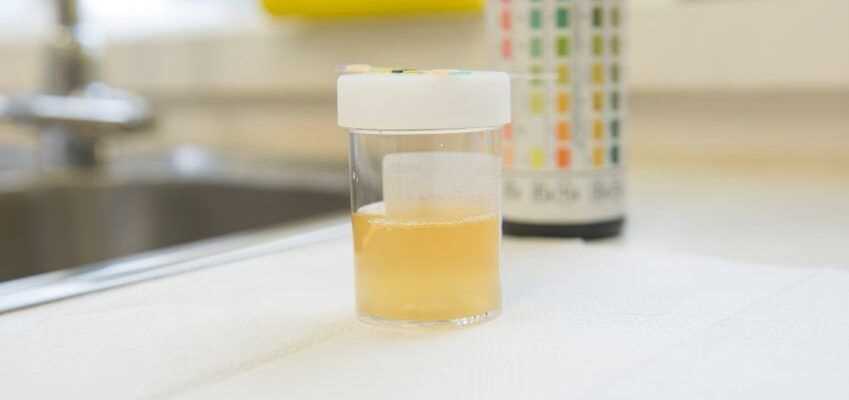Especially with a bladder infection, the urine can become cloudy and smell pungent. However, the symptom also has other possible causes and can occur during pregnancy. The causes of cloudy urine and smell, how dangerous the disease sign is and when you should do something.
Usually urine is clear like water, slightly yellow in color and hardly smells. The liquid is an excretion product of the body: Our kidneys filter about 180 liters of urine from the blood plasma every day and remove the ingredients that the body can use.
What remains is the final urine, which is excreted via the ureter and bladder. This urine consists mainly of water, the slight yellow color of the urine comes from the so-called urochromes. These are yellow dyes. In turn, they are breakdown products of the bilirubin. In addition, urine contains substances such as:
- uric acid
- urea
- Creatinine
- Salts
- Hormones
Cloudy urine with flakes and / or pungent odor
However, sometimes the appearance and smell of urine change. It becomes cloudy, develops an unpleasant, pungent smell, and flakes can also fall out. This means that the composition of the urine is no longer correct and the urine contains metabolic products that should not normally be in it. The urine contains one or more of the following substances in high concentration:
- Protein – this happens when the kidneys can no longer properly filter the urine.
- Leukocytes – the white blood cells are used to fight inflammation.
- Bacteria, mucus and pus particles – are flushed out with urine in case of inflammation.
- Blood cells – pass into the urine as a result of certain infectious diseases such as inflammation of the kidneys and other inflammatory processes, which in turn turns darker and slightly brown.
Cloudy urine – the most common causes
But why does the composition of urine change? There are a number of reasons for this. Some are harmless. For example, certain foods can easily discolour urine, such as beetroot or citrus. After urinating several times, the phenomenon has disappeared. Even if the fluid intake is too low, the urine thickens, so to speak, and turns dark yellow to orange. Drinking enough immediately will make up for it. Mostly, the following diseases can be considered as causes for cloudy urine, flakes in the urine and strong smell:
What cloudy urine can mean for men
There are also gender-specific causes for cloudy urine, which only affect men or women. In men, for example, the urine can change when the prostate is inflamed (prostatitis).
The benign enlargement of the prostate (benign prostatic hyperplasia, BPH for short) also affects the appearance and smell of urine: the enlarged prostate hinders the urinary outflow from the bladder. Residual urine remains in it, which allows bacteria to multiply quickly.
Cloudy urine – mostly a women's problem
Undisputedly, the symptom cloudy urine occurs particularly often in women. The explanation: Because of their short urethra, women get a bladder infection very easily and thus a changed urine as a symptom of the infection.
Bacteria, for example from the intestine, migrate through the urethral opening into the urethra and quickly get into the bladder. Women who have had bladder infections more often are therefore particularly alert if their urine looks and smells different than usual – because it may be the first sign of a urinary tract infection.
What to do with cystitis?
TargetVideo
Cloudy urine during pregnancy
The composition of urine can also change during pregnancy. For example, strong yellowing and a sweet smell indicate the pregnancy hormone hCG (human chorionic gonadotropin) there. It is formed in the placenta. Many pregnancy tests take advantage of this by determining the level of hCG in the urine with a urine sample.
There are a number of explanations for cloudy urine during pregnancy. The cause can be harmless, for example, as a result of a changed diet. Many women eat more and more dairy products during pregnancy. Both factors can change the urine somewhat.
The bladder infections that affect many women, especially in the last three months of pregnancy, are less harmless. Often the first signs of cystitis are cloudy urine, flakes in the urine or unpleasant smell. Burning and painful urination are also common.
The hormonal change in pregnancy widens the urinary tract. Bacteria can rise into the bladder all the faster. Because urinary tract infections can lead to complications during pregnancy – such as premature birth – targeted treatment by the doctor is important.
The same applies to gestosis (preeclampsia or pregnancy poisoning). The blood sugar rises dangerously. This can also be shown by a high proportion of protein in the urine. This becomes clear through cloudiness. Pregnant women should therefore have any changes in urine clarified by the doctor in order to avert serious consequences for themselves and the unborn child.
Cloudy urine – when to see a doctor and how to treat?
The symptom of cloudy urine can be harmless if, for example, it is caused by the diet or occurs only briefly. On the other hand, various diseases and changes in the body cause the clouding. You should always go to the doctor if any of these signs appear:
With a urine test, the doctor can determine what is actually behind the symptom of cloudy urine. However, the laboratory test, including the creation of a bacterial culture, takes several days. Until then, however, treatment often begins – depending on the additional signs.
-

Treat urinary tract infections naturally and tolerably.
Herbal help – applicable at the first sign of cystitis.
Continue reading
For example: if urine becomes cloudy and painful when you urinate, it is usually a bladder infection. Herbal medicines, for example, with components of the diuretic squirrel root have proven themselves here.
If there is additional blood in the patient's urine, however, the doctor will prescribe an antibiotic to prevent the urinary tract infection from spreading to the kidney area.

